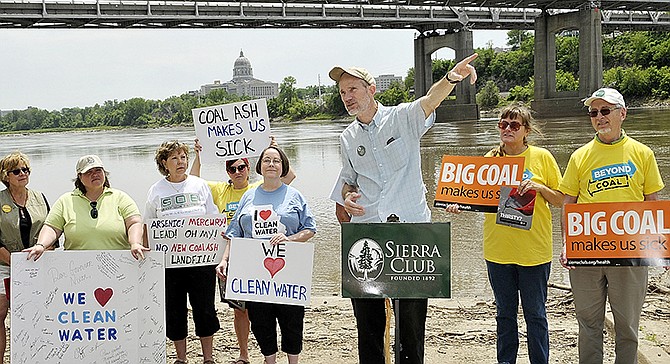The Sierra Club and Labadie Environmental Organization are urging the state of Missouri to reject proposals to build coal ash ponds or coal ash landfills in state floodplains and to perform ground-water monitoring in the areas of existing ones.
"Coal ash is what's left over after you burn coal to make electricity," said John Hickey, director of the Sierra Club Missouri chapter. "(Coal ash includes) heavy metals like mercury, lead and arsenic, which are what makes coal ash so dangerous."
The Sierra Club identifies itself as a group devoted to exploring, enjoying and protecting the planet. The Labadie Environmental Organization is a nonprofit that seeks to inform and educate the Labadie community about environmental issues, inspire positive change and encourage practices for sustainability.
On Wednesday, both environmental groups delivered a petition with 3,500 signatures to Gov. Jay Nixon's office and 1,000 formal comments to Missouri's Department of Natural Resources. The petitions urged Nixon to reject all proposals to build coal ash landfills in the state's floodplains and to support strong safeguards on disposing coal ash waste. Prior to the delivery, they hosted a press conference on the banks of the Missouri River.
Their concern is that the coal ash is washed or even dumped into Missouri rivers.
A recent report by the Sierra Club and Earthjustice identified 39 coal ash ponds in Missouri - one identified as a high-hazard site, five as significant hazard sites and four as cases of water contamination or spills. High-hazard means a failure of the pond is likely to take human lives; significant hazard means a failure would cause economic or environmental damage.
The closest power plant to Jefferson City that has generated coal ash is the Chamois Power Plant, although it ceased operations in September.
"We don't want to wait until this becomes a hazard," Hickey said of why the state should perform ground-water monitoring in these areas.
He said rivers are great sources for recreation.
"Tourism is a main part of the economy, and clean water is a part of that," he said. "We recreate on the water, and it's even part of our drinking water."
Joe Bachant, a former Missouri Department of Conservation staff member and expert on stream monitoring and heavy metal testing, said if we stop generating toxic metals into the environment, they shouldn't be an issue for thousands of years.
"So, it needs to stop," he said.
He said the efforts go back to an old saying that "No one worries about the well until it runs dry."
"In my mind, it's now or never," he said.
Patricia Schuba, president of the Labadie Environmental Organization, said the grassroots nonprofit has been engaging with the state and Ameren in an effort to get coal ash out of Missouri's floodplains.
"We're asking Gov. Nixon to ensure that we can have access to clean water, which is a basic right that every community should have guaranteed," she said. "The struggle of our community to keep coal ash pollution out of our floodplain is just one example of a statewide issue that plagues so many waterways in Missouri."

